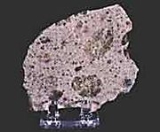
Diogenite
Encyclopedia

HED meteorite
HED meteorites are a subgroup of achondrite meteorites. HED stands for "Howardite–Eucrite–Diogenite".These achondrites came from a differentiated parent body and experienced extensive igneous processing not much different from the magmatic rocks found on Earth and for this reason they closely...
group, a type of achondritic
Achondrite
An achondrite is a stony meteorite that does not contain chondrules. It consists of material similar to terrestrial basalts or plutonic rocks and has been differentiated and reprocessed to a lesser or greater degree due to melting and recrystallization on or within meteorite parent bodies...
stony meteorite
Meteorite
A meteorite is a natural object originating in outer space that survives impact with the Earth's surface. Meteorites can be big or small. Most meteorites derive from small astronomical objects called meteoroids, but they are also sometimes produced by impacts of asteroids...
s.
Origin and composition
Diogenites originates from deep within the crust of the asteroidAsteroid
Asteroids are a class of small Solar System bodies in orbit around the Sun. They have also been called planetoids, especially the larger ones...
4 Vesta
4 Vesta
Vesta, formally designated 4 Vesta, is one of the largest asteroids, with a mean diameter of about . It was discovered by Heinrich Wilhelm Olbers on March 29, 1807, and is named after the Roman virgin goddess of home and hearth, Vesta....
, and as such are part of the HED meteorite
HED meteorite
HED meteorites are a subgroup of achondrite meteorites. HED stands for "Howardite–Eucrite–Diogenite".These achondrites came from a differentiated parent body and experienced extensive igneous processing not much different from the magmatic rocks found on Earth and for this reason they closely...
group. There are about 40 distinct members known.
Diogenites are composed of igneous rocks of plutonic origin, having solidified slowly enough deep within Vesta's
4 Vesta
Vesta, formally designated 4 Vesta, is one of the largest asteroids, with a mean diameter of about . It was discovered by Heinrich Wilhelm Olbers on March 29, 1807, and is named after the Roman virgin goddess of home and hearth, Vesta....
crust to form crystals which are larger than in the eucrite
Eucrite
Eucrites are achondritic stony meteorites, many of which originate from the surface of the asteroid 4 Vesta and as such are part of the HED meteorite group. They are the most common achondrite group with well over 100 distinct finds at present....
s. These crystals are primarily magnesium
Magnesium
Magnesium is a chemical element with the symbol Mg, atomic number 12, and common oxidation number +2. It is an alkaline earth metal and the eighth most abundant element in the Earth's crust and ninth in the known universe as a whole...
-rich orthopyroxene, with small amounts of plagioclase
Plagioclase
Plagioclase is an important series of tectosilicate minerals within the feldspar family. Rather than referring to a particular mineral with a specific chemical composition, plagioclase is a solid solution series, more properly known as the plagioclase feldspar series...
and olivine
Olivine
The mineral olivine is a magnesium iron silicate with the formula 2SiO4. It is a common mineral in the Earth's subsurface but weathers quickly on the surface....
.
Name
Diogenites are named for Diogenes of Apollonia, an ancient Greek philosopher who was the first to suggest an outer space origin for meteorites.External links
- Diogenite images - Meteorites Australia

